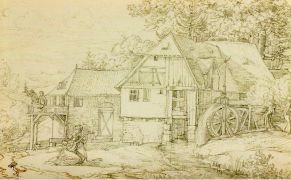Goethe’s Muse and Co-Author: Marianne von Willemer
Thursday, February 6, 2025

Our RISM A-Z series reaches letter W today and, as so often, we decide in favor of a lady, also with an eye to local history.
Marianne von Willemer (born 20 November 1784, Linz (?) – died 6 December 1860, Frankfurt am Main) was an Austrian-born actress and dancer. After her mother Elisabeth Pirngruber married Joseph M. Georg Jung in 1788, she adopted the family name Jung, presumably to conceal her illegitimate parentage.
Marianne is first mentioned on a Frankfurt playbill on 26 December 1798. The fourteen-year-old took on roles in operas (Der Spiegelritter), Singspiele (Der kleine Matrose), and ballet performances (Die geraubte Braut). Until April 1800, her name can be associated with over 40 theater performances in Frankfurt am Main. Marianne was then taken in as a foster daughter in the house of banker Johann Jacob von Willemer (1760–1838), where her musical education was further encouraged. She received guitar lessons, but her curriculum also included languages and literature. In addition to private performances, she also appeared in public concerts between 1805 and 1807. Marianne and her foster father got married on 27 September 1814, the same year that Marianne met Johann Wolfgang von Goethe for the first time.
In a letter dated 10 April 1815, Johann Jacob Willemer invited Goethe to make another trip to his hometown:
“Why don’t you recover soon from the discomfort of the Weimar winter on the banks of the Main? You could […] stay with us at the mill. There is plenty of room, and my wife and I would never have felt greater joy than to see you as our guest. When you are tired of the sun and your work, she will sing some of your songs to you.”
Goethe arrived at the von Willemer estate on 12 August and stayed at the Gerbermühle until 17 September. In addition to the Willemers and Goethe, the young architect Sulpiz Boisserée was also a guest during these days. In the mornings, Goethe worked mainly on his West-Eastern Divan. In the evening, he recited the verses he had written during the day, and Marianne not only sang his songs, but increasingly entered into a lyrical dialog with him. In Goethe’s late work West-Eastern Divan, published in 1819, which also contains several poems written by Marianne von Willemer, he shows his great esteem for his friend. Among Goethe’s many muses, Marianne – whom Goethe immortalized as Suleika – was the only one to co-author one of his works. However, her authorship was revealed only posthumously. Not only Franz Schubert set to music the texts “Was bedeutet die Bewegung” (Suleika I) and “Ach, um deine feuchten Schwingen” (Suleika II) by Marianne von Willemer (RISM Catalog | RISM Online); Felix Mendelssohn Bartholdy, his sister Fanny Hensel, and Johann Friedrich Reichardt also drew on them.
Image: Gerbermühle, Frankfurt am Main, Painting by Sulpiz Boisserée, 1817. Via Wikimedia
Share Tweet EmailCategory: RISM A-Z

